Charters Towers has a slogan which is 'Welcome to Our World'. For tourism purposes the town has really grabbed onto 'The World' bit, and good for them! The town was affectionately referred to as 'The World' when it was the second largest city in Queensland and it was said "That anything one might desire could be had in the 'Towers', leaving no reason to travel elsewhere".Gold was discovered by chance in 1871. A young aboriginal boy Jupiter Mosman, went looking for a horse that had been spooked by a storm. He found a large gold nugget that had been washed into the creek bed, at the bottom of what is now 'Tower Hill'. The party then explored the area and identified many promising reefs. It took 24 days to travel back to register the discovery. The town was named after the 'Gold Commissioner' whose surname was Charters. The 'Towers' comes from the hills looking like 'Towers' above the stream that ran down from the hills. A total of ten major gold reefs were eventually mined and ore crushing operations began in July 1872.
[ The railway arrived in 1882, gold production was rising, whilst the mining operations were increasing in depth. The depths of the mines were as much as 3,000 feet. Over 100 'Poppet Heads' were scattered throughout the town. There were 65 Hotels, 11 Crushing Mills and the first regional 'Stock Exchange in Australia' was formed, allowing the people of Charters Towers to be involved through speculation and investment in company shares. The 'Stock Exchange Arcade' still proudly stands at the intersection of Gill and Mosman Streets, thanks to community support when its demolition was proposed. It was designed and built in 1888 by a Sydney architect and Sydney builders. At that time it was known as 'Royal Arcade', housing the 'Charters Towers Stock Exchange'. The 'Stock Exchange' was linked to the world via telegraph, with three calls a day, six days a week. It is written that 'So important was Charters Towers at this time that the world gold price was set right in this arcade'.
Beside thearcade is the Visitor Information Centre and that building alos has quite a history. It was originally built on the site where City Hall stands today, as premises for the Queensland National Bank. It was built in 1880 at a cost of 2350 pounds. In 1891 the Queensland Bank replaced it with new premises and the building was sold to the Union Bank and moved sideways to the adjacent block. In the 1930's the building was moved to the back of the block for municipal purposes including the use as a Band Hall. In 1996 it was moved again to the middle of the block, restored and renovated to become the Visitor Information Centre. In 2003 it was moved to its present location to accommodate a revamped Visitor Information Centre and the Ghosts of Gold Heritage Trail Orientation Room.Peter and I walked the 'One Square Mile' with a guide on Monday. We actually went through the 'Indecision Bit' about this tourist attraction! We thought we could probably just walk the streets ourselves and take in the magnificent architecture, rather than pay $10.00 each to walk with a guide. But we decided to go back after lunch and go on the 1.30pm tour. It turned out that numbers normally drop off after lunch and we were lucky enough to be the only two with Erica. It was well worth the money. Erica gave us a very informative and interesting talk on the historic buildings in the city. They truly are 'Very Swish' and it was so great to see that the Regional Council has in many cases become involved with their use and upkeep. One of the most beautiful buildings was the 'World Theatre'. The building was the Commerce Bank when it was built in 1891. It was in this building in 1902 that the 'Mosman Street' tragedy took place. The 'World Theatre' has its own celebrity ghost, the ghost of the man murdered in the tragedy. It is said "The ghost is often seen and felt in the complex"! The story goes that businessman Graham Haygarth was shot in the head here by business associate David Brown after a dispute over Brown's pay. He pulled out a pistol and shot Haygarth behind the left ear. Blood spurted on the table, and the stain is still visible today as the table has remained in the building. Brown was hanged in Brisbane's Boggo Road Gaol, but Haygarth's ghost appears regularly and is called the "Phantom of the Theatre". In 1996 the building was converted to a 660 seat performing arts theatre, two cinemas, restaurant and public art gallery.The building has a unique blend of heritage architecture and state of the art technology. The foyer houses several pieces of the 'Heritage Scuplture Trail'.Funny over here! Most regional towns are cities, regardless of their population. Charters Towers has a population of approximately 9,000 but in it's hey day the population was 30,000. Sadly gold production did not last for long and by 1910 production had peaked and over the next 20 years there was a steady decline. One of the towns '120 Facts' is that 6,800,000 ozs of gold was produced between 1872 - 1911. The gold was concentrated into veins and was Australia's richest major field with an average grade of 34 grams per tonne, which I'm told is very high!Once gold mining became uneconomic, labour was hard to find and as the mines drove deeper, ventilation and water problems arose. The production was similar across Australian gold mines. There was a revival in 1980 through to 2000 when some of the older mines were found to be profitable, but there is little gold mining in the region today.The 'Venus Battery' was one of the ore crushing mills that operated in the city. The battery is of national cultural significance as the largest surviving battery relic in Australia and oldest surviving battery in Queensland. It became a 'State Battery' in 1919 to provide ore crushing facilities for small miners. It ceased commercial operations in 1973 after a century of service. Tours are conducted on the hour from 10.00am until 3.00pm through the Regional Council. It is quite amazing what they have done with the old mill, making it safe for the tours, but still enabling you to fully appreciate the working conditions and just how the whole operation did work. Much better than the 'Mogo Mine' Val! To start the tour they have a hologram which presents the story of the first few years of the mill. The tour guide then comes back and takes you through the crushing process. Then at the end you sit down where the old steam boilers used to be, wondering how on earth we are going to see anything here! There were two tubes overhead that perhaps screens could have dropped down from. Then to our amazement water started spraying out of them and the film was projected onto the falling water. It gave a ghostly effect, which was the idea. As with all gold towns, there are stories of many deaths and ghosts that haunted the premises. Mr E.H.T. Plant built the battery and he had some interesting tales to tell.Charters Towers is certainly all about the G's we thought: It has the 'Ghost of Gold' Heritage Trail. It is all about the discovery of Gold at the foot of Towers Hill, Greed at the Stock Exchange, the Grandeur of the historic 'One Mile Square' and the Ghosts. Erica also added another three 'G's' when we did the walk with her. There were plenty of Goats for meat and milk, Grog and Girls! I did ask Erica whether there was a 'Hay Street' in Charters Towers and apparently the Royal Private Hotel was the one. It was the first hotel to be built and it is the one at the top of the hill. Erica did say that it is on her 'Bucket List' to visit Kalgoorlie one day and do the 'Hay Street Tour'! To finish our touring of the town we went out to the cattle yards. The tourist brochure says there is a cattle sale here every Wednesday. There were lots of cattle trucks and we did see cattle in the yards when we drove in on Sunday. There are lots more now! But there is no sale tomorrow and there hasn't been a sale for 2 months. Can't believe everything you read! Pete did have a good chat with a stockie though. The cattle are there for quarantine purposes. They will be reloaded in the next couple of days and transported to Townsville, where they will be loaded on the ship to go to Vietnam. All 13,000 of them. They only hold sales when there is no live cattle market.
Beside thearcade is the Visitor Information Centre and that building alos has quite a history. It was originally built on the site where City Hall stands today, as premises for the Queensland National Bank. It was built in 1880 at a cost of 2350 pounds. In 1891 the Queensland Bank replaced it with new premises and the building was sold to the Union Bank and moved sideways to the adjacent block. In the 1930's the building was moved to the back of the block for municipal purposes including the use as a Band Hall. In 1996 it was moved again to the middle of the block, restored and renovated to become the Visitor Information Centre. In 2003 it was moved to its present location to accommodate a revamped Visitor Information Centre and the Ghosts of Gold Heritage Trail Orientation Room.Peter and I walked the 'One Square Mile' with a guide on Monday. We actually went through the 'Indecision Bit' about this tourist attraction! We thought we could probably just walk the streets ourselves and take in the magnificent architecture, rather than pay $10.00 each to walk with a guide. But we decided to go back after lunch and go on the 1.30pm tour. It turned out that numbers normally drop off after lunch and we were lucky enough to be the only two with Erica. It was well worth the money. Erica gave us a very informative and interesting talk on the historic buildings in the city. They truly are 'Very Swish' and it was so great to see that the Regional Council has in many cases become involved with their use and upkeep. One of the most beautiful buildings was the 'World Theatre'. The building was the Commerce Bank when it was built in 1891. It was in this building in 1902 that the 'Mosman Street' tragedy took place. The 'World Theatre' has its own celebrity ghost, the ghost of the man murdered in the tragedy. It is said "The ghost is often seen and felt in the complex"! The story goes that businessman Graham Haygarth was shot in the head here by business associate David Brown after a dispute over Brown's pay. He pulled out a pistol and shot Haygarth behind the left ear. Blood spurted on the table, and the stain is still visible today as the table has remained in the building. Brown was hanged in Brisbane's Boggo Road Gaol, but Haygarth's ghost appears regularly and is called the "Phantom of the Theatre". In 1996 the building was converted to a 660 seat performing arts theatre, two cinemas, restaurant and public art gallery.The building has a unique blend of heritage architecture and state of the art technology. The foyer houses several pieces of the 'Heritage Scuplture Trail'.Funny over here! Most regional towns are cities, regardless of their population. Charters Towers has a population of approximately 9,000 but in it's hey day the population was 30,000. Sadly gold production did not last for long and by 1910 production had peaked and over the next 20 years there was a steady decline. One of the towns '120 Facts' is that 6,800,000 ozs of gold was produced between 1872 - 1911. The gold was concentrated into veins and was Australia's richest major field with an average grade of 34 grams per tonne, which I'm told is very high!Once gold mining became uneconomic, labour was hard to find and as the mines drove deeper, ventilation and water problems arose. The production was similar across Australian gold mines. There was a revival in 1980 through to 2000 when some of the older mines were found to be profitable, but there is little gold mining in the region today.The 'Venus Battery' was one of the ore crushing mills that operated in the city. The battery is of national cultural significance as the largest surviving battery relic in Australia and oldest surviving battery in Queensland. It became a 'State Battery' in 1919 to provide ore crushing facilities for small miners. It ceased commercial operations in 1973 after a century of service. Tours are conducted on the hour from 10.00am until 3.00pm through the Regional Council. It is quite amazing what they have done with the old mill, making it safe for the tours, but still enabling you to fully appreciate the working conditions and just how the whole operation did work. Much better than the 'Mogo Mine' Val! To start the tour they have a hologram which presents the story of the first few years of the mill. The tour guide then comes back and takes you through the crushing process. Then at the end you sit down where the old steam boilers used to be, wondering how on earth we are going to see anything here! There were two tubes overhead that perhaps screens could have dropped down from. Then to our amazement water started spraying out of them and the film was projected onto the falling water. It gave a ghostly effect, which was the idea. As with all gold towns, there are stories of many deaths and ghosts that haunted the premises. Mr E.H.T. Plant built the battery and he had some interesting tales to tell.Charters Towers is certainly all about the G's we thought: It has the 'Ghost of Gold' Heritage Trail. It is all about the discovery of Gold at the foot of Towers Hill, Greed at the Stock Exchange, the Grandeur of the historic 'One Mile Square' and the Ghosts. Erica also added another three 'G's' when we did the walk with her. There were plenty of Goats for meat and milk, Grog and Girls! I did ask Erica whether there was a 'Hay Street' in Charters Towers and apparently the Royal Private Hotel was the one. It was the first hotel to be built and it is the one at the top of the hill. Erica did say that it is on her 'Bucket List' to visit Kalgoorlie one day and do the 'Hay Street Tour'! To finish our touring of the town we went out to the cattle yards. The tourist brochure says there is a cattle sale here every Wednesday. There were lots of cattle trucks and we did see cattle in the yards when we drove in on Sunday. There are lots more now! But there is no sale tomorrow and there hasn't been a sale for 2 months. Can't believe everything you read! Pete did have a good chat with a stockie though. The cattle are there for quarantine purposes. They will be reloaded in the next couple of days and transported to Townsville, where they will be loaded on the ship to go to Vietnam. All 13,000 of them. They only hold sales when there is no live cattle market.
We think Charters Towers has been well worth the visit. Can't say that we would necessarily come back again for any length of time, but it is definitely rich in history and the beautiful architecture is certainly 'A Must See'. 24 photos

 Queensland, Australia
Queensland, Australia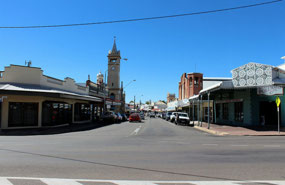
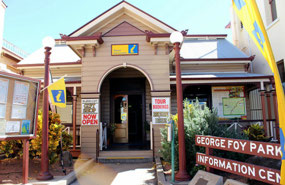

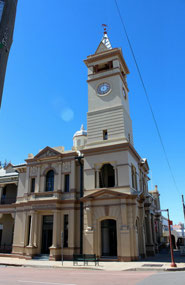
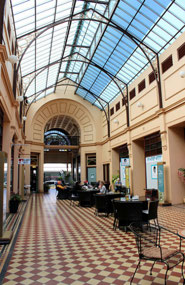
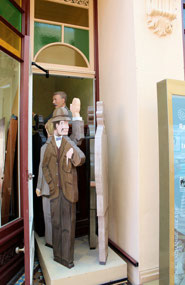


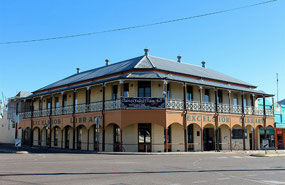
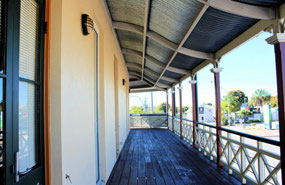

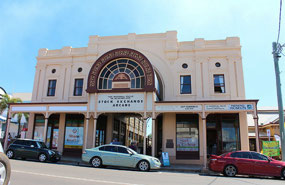
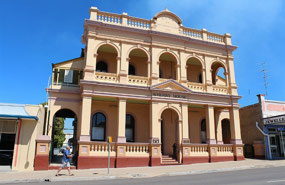

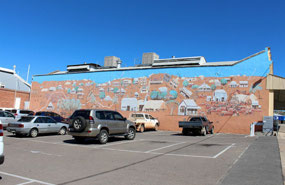
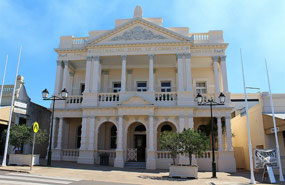
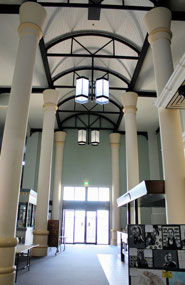
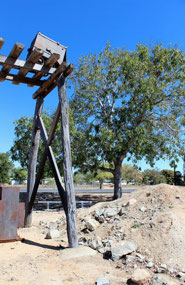
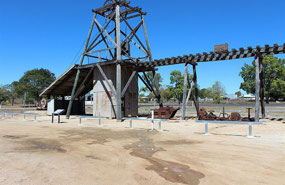
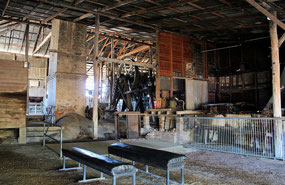
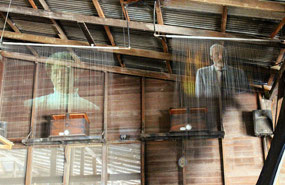
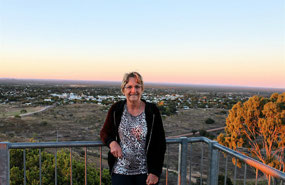
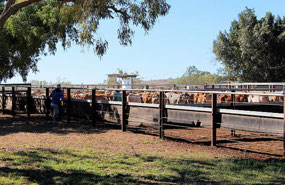
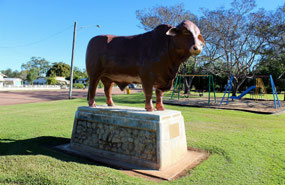
2025-05-22